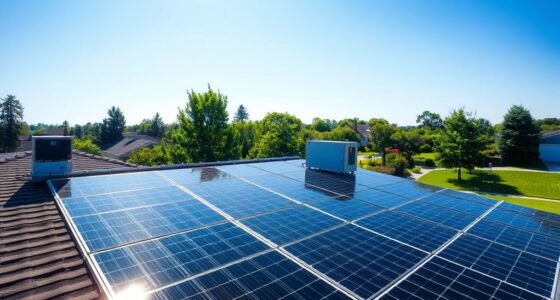Geothermal energy taps into the Earth’s internal heat, providing a clean and sustainable power source. Harnessing this energy occurs through various technologies, like dry steam and binary cycle plants, which convert heat into electricity. It’s not just for power generation; you can use it in agriculture and building heating too. With its low emissions and economic benefits, geothermal energy is gaining traction. Discover how it impacts different sectors and its future potential.
Key Takeaways
- Geothermal energy harnesses Earth’s internal heat, providing a sustainable and renewable source of clean power.
- Various technologies, like dry steam and binary cycle plants, efficiently convert geothermal heat into electricity.
- Geothermal power generation significantly reduces carbon emissions, contributing to a cleaner environment compared to fossil fuels.
- Ground source heat pumps utilize geothermal energy for efficient heating and cooling in residential and commercial buildings.
- Despite challenges like high development costs, innovations and international collaboration enhance geothermal energy’s viability and efficiency.
Understanding Geothermal Energy
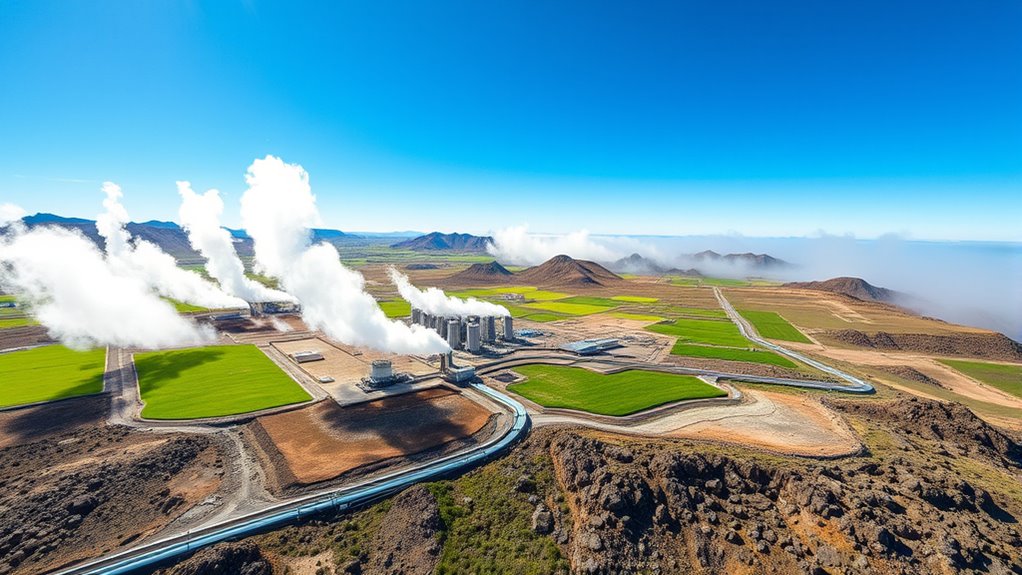
Geothermal energy, which comes from the Earth’s internal heat, is a powerful and renewable resource that you mightn’t be fully aware of.
Originating from the Greek words for “earth” and “heat,” this energy source stems from radioactive decay and the Earth’s formation. The temperature gradient increases by about 30°C for every kilometer you go below the surface, revealing vast potential. Temperature increases below the surface contribute significantly to the availability of geothermal energy. Additionally, sound waves from geothermal activities can impact local ecosystems by influencing the behavior of nearby wildlife. Furthermore, this energy source is known for its predictive analytics capabilities in assessing potential geothermal resource viability. Heat pumps can also be integrated with geothermal systems for improved energy efficiency.
Geothermal energy isn’t just for electricity generation; it also heats homes, supports agriculture, and serves therapeutic purposes in spas.
Found mainly near tectonic plate boundaries, regions like the Pacific Ring of Fire hold abundant geothermal resources. Countries like Iceland and the Philippines showcase the global reliance on this sustainable energy, making it an essential player in our energy future.
Technologies for Geothermal Power Generation
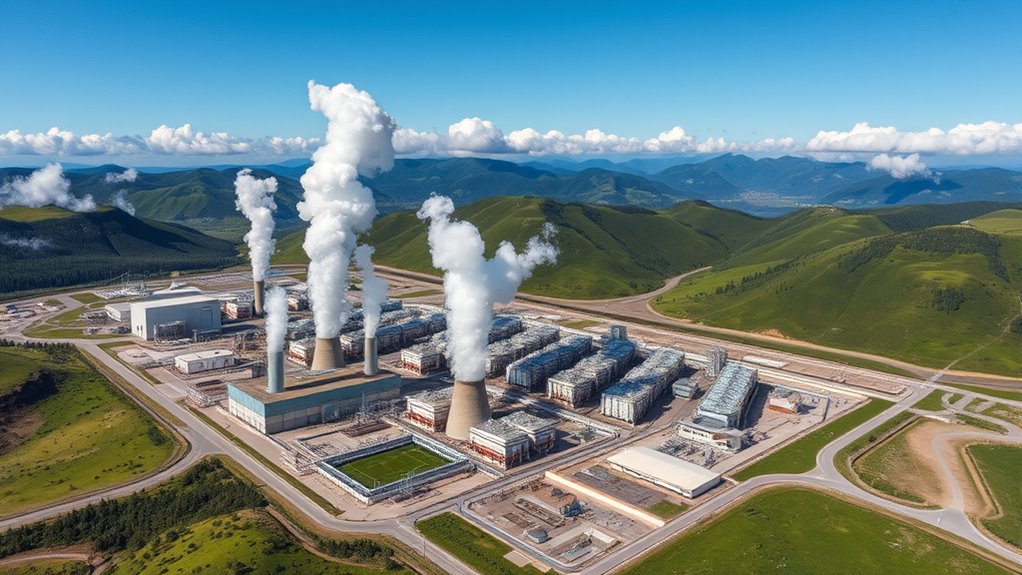
While exploring the potential of geothermal energy, you’ll find a variety of technologies designed for power generation.
Dry steam power plants harness natural steam from underground reservoirs to drive turbines, while flash steam plants convert high-temperature water into steam for electricity. Different types of geothermal resources play a crucial role in determining which technology is most suitable for a specific location. Additionally, hydrogen fuel cells are being explored as complementary technologies to enhance energy systems. Geothermal energy has a small carbon footprint, making it an environmentally friendly option. Regular maintenance of geothermal systems can significantly improve their efficiency and longevity through effective servicing.
Dry steam and flash steam power plants efficiently convert natural geothermal resources into electricity, driving sustainable energy solutions.
Binary cycle power plants utilize lower-temperature water to heat a working fluid that powers turbines. For enhanced efficiency, combined cycle plants capture waste heat.
Additionally, wellhead generators offer small-scale electricity generation.
Advanced geothermal systems, like ultra-deep and enhanced geothermal systems, push boundaries further.
Geothermal heat pumps and district heating systems provide efficient heating and cooling solutions.
These technologies collectively make geothermal energy a sustainable and reliable source of clean power.
Types and Location of Geothermal Resources

Understanding the types and locations of geothermal resources is essential for harnessing this renewable energy source effectively.
You’ll encounter hydrothermal systems, which tap into natural reservoirs, and vapor-dominated systems like Larderello, with temperatures up to 300 °C. Liquid-dominated systems are more common, often found near volcanoes, while enhanced geothermal systems (EGS) use injected water to improve rock permeability. Geothermal energy has been utilized for heating and electricity generation for millennia, demonstrating its long-standing importance as a resource. Effective management of geothermal resources can significantly enhance their sustainability and output, and the use of ground source heat pumps can further optimize energy efficiency in these systems. The incorporation of advanced technology in geothermal systems can lead to improved performance and reliability.
Globally, geothermal resources are abundant, particularly in the Pacific Ring of Fire, and countries like Iceland and El Salvador heavily utilize this energy. The U.S. leads in geothermal electricity generation, especially in California and Nevada.
Additionally, regions along tectonic plate boundaries, such as Kenya and the Philippines, hold significant geothermal potential waiting to be tapped.
Applications of Geothermal Energy in Various Sectors
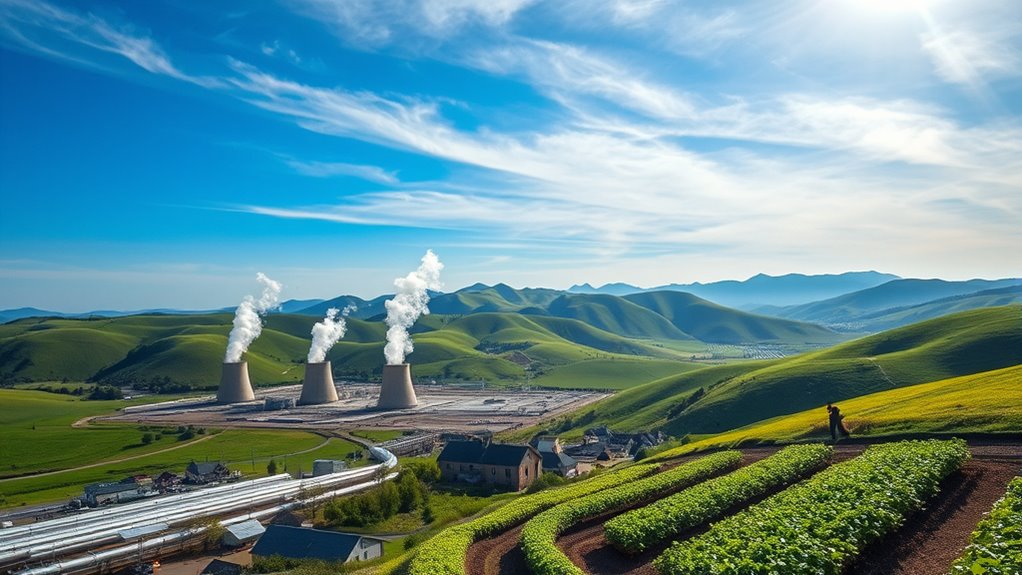
As you explore the diverse applications of geothermal energy, you’ll find its versatility spans multiple sectors, from electricity generation to agriculture.
Geothermal power plants harness heat from deep within the Earth, generating reliable electricity—about 92 billion kWh globally in 2022. Geothermal energy features consistent baseload characteristics, allowing for around-the-clock electricity production that enhances grid stability. Additionally, geothermal power plants can achieve efficiency ratings of 300% to 600%, making them a sustainable energy solution.
In agriculture, geothermal heat aids in soil warming, greenhouse heating, and drying crops, while aquaculture benefits from a stable heat source for fish cultivation.
Industrial applications include food processing, cement drying, and even biofuel production. The efficiency of geothermal heat pumps allows for significant energy savings, further promoting sustainability in industrial processes.
Ground source heat pumps, popular in residential and commercial settings, efficiently heat and cool buildings by utilizing the Earth’s constant temperature.
Economic and Environmental Benefits of Geothermal Power
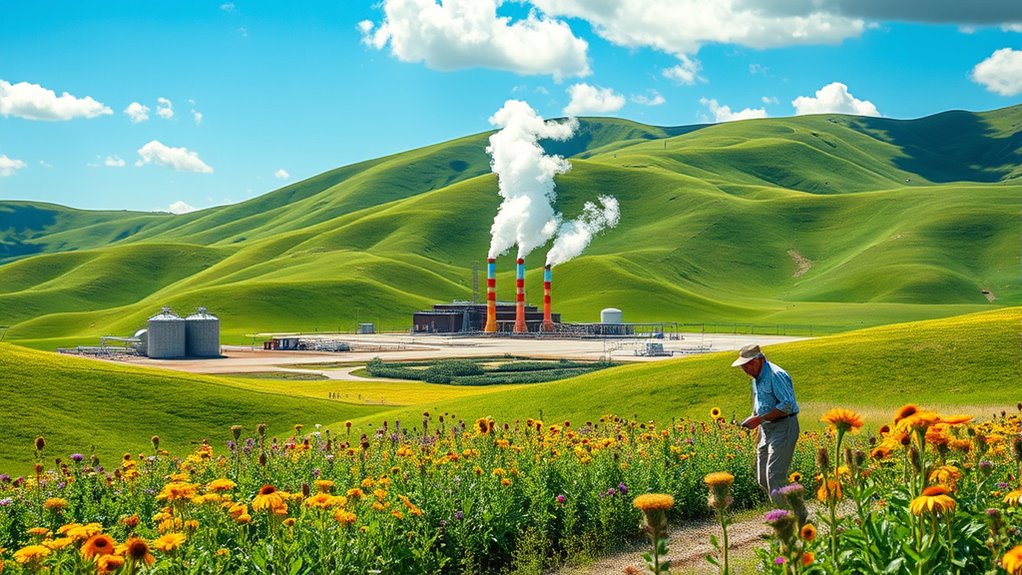
Geothermal power offers considerable economic and environmental advantages that can transform energy landscapes.
You’ll find that geothermal projects create jobs, generating around 1.17 permanent jobs per MW at operational plants. During construction, they need about 3.1 person-years per MW, fostering local economic growth. Additionally, geothermal projects contributed approximately $$29 million in annual property taxes in 2013, benefiting local communities. The investment strategy in geothermal energy can lead to long-term financial stability for local economies. Furthermore, many geothermal plants are designed with sustainable practices that enhance their overall efficiency and environmental impact.
Geothermal energy also boasts low emissions, greatly cutting your carbon footprint compared to fossil fuels. It uses less land and conserves water with closed-loop systems, preserving natural resources.
Additionally, geothermal operations produce minimal solid waste, contributing to a cleaner environment.
Future Developments and Challenges in Geothermal Energy
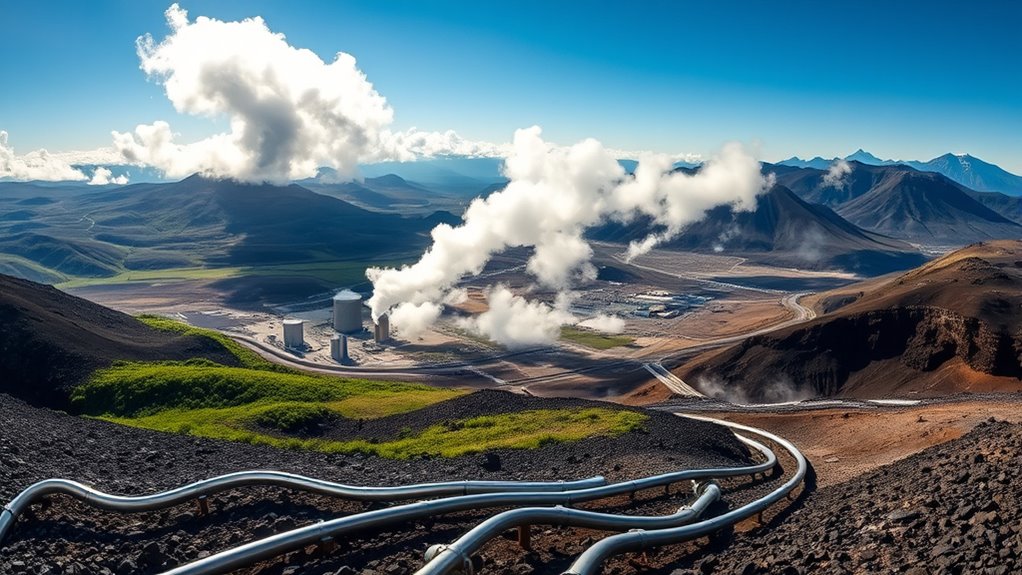
While the economic and environmental benefits of geothermal power are significant, the future of this energy source hinges on overcoming several key challenges and embracing innovative technologies. Enhanced Geothermal Systems (EGS) and Advanced Geothermal Systems (AGS) promise to access geothermal energy in previously unsuitable areas, but geological constraints and seismic risks remain concerns. Enhanced geothermal systems allow access to geothermal heat in new locations using hydraulic fracturing techniques, which could enhance energy production. Additionally, the integration of AI tools in resource monitoring could streamline the development of geothermal projects and optimize energy output. You’ll see advancements like supercritical geothermal systems, which could produce five to ten times more energy than conventional wells. Furthermore, AI-driven storytelling techniques could help communicate the benefits of geothermal energy to the public more effectively. Additionally, the expected increase in renewable energy technologies efficiency by over 40% could further support the viability of geothermal energy initiatives. Collaboration on international projects, such as DEEPEN, helps explore new resources. However, high costs and public perception issues could hinder progress.
Frequently Asked Questions
What Are the Main Countries Utilizing Geothermal Energy Today?
When you look at the main countries utilizing geothermal energy today, you’ll find the United States leading with the highest generation capacity.
Indonesia and the Philippines follow, harnessing significant geothermal resources. Turkey and New Zealand also make the top five.
Countries like Iceland and Kenya maximize geothermal for heating and electricity, while others, like Japan, have potential yet to be fully explored.
Each country’s approach showcases the diverse applications of this renewable resource.
How Does Geothermal Energy Compare to Solar and Wind Energy?
When it comes to energy sources, you’ve got to weigh your options carefully.
Geothermal energy stands out with its reliability, providing consistent power unlike solar and wind, which depend on weather conditions.
While solar and wind have seen rapid growth due to decreasing costs, geothermal’s high upfront investment can be a hurdle.
However, its low operational costs make it an attractive long-term choice for clean energy production.
Can Geothermal Energy Be Used for Residential Purposes?
Absolutely, geothermal energy can be used for residential purposes.
You can install ground source heat pumps to efficiently heat and cool your home, greatly reducing your energy bills.
These systems harness the Earth’s natural heat, making them a sustainable alternative to traditional HVAC systems.
With minimal maintenance and potential government incentives, you’ll find it a smart investment for both your comfort and the environment.
Embrace the benefits of this renewable energy source!
What Factors Influence the Efficiency of Geothermal Energy Systems?
Imagine stepping into a home that’s perfectly cool in summer and warm in winter, all thanks to geothermal energy.
The efficiency of these systems hinges on several factors. You’ll want to evaluate the coefficient of performance (COP) for heating and the energy efficiency ratio (EER) for cooling.
Soil conditions, installation costs, and the longevity of the system also play significant roles, ensuring you enjoy consistent comfort while saving on energy bills.
Are There Any Risks Associated With Geothermal Energy Extraction?
Yes, there are several risks associated with geothermal energy extraction.
You might face hazards like exposure to high-temperature fluids, which can cause burns, and electrical hazards common in industrial settings. Additionally, improper fall protection can lead to accidents, while silica exposure poses respiratory risks.
Environmental concerns include habitat disruption and potential water contamination.
It’s essential to implement safety measures and conduct thorough risk assessments to mitigate these dangers effectively.
Conclusion
In a world where we’re all craving cleaner energy, geothermal power stands out like a hidden gem beneath our feet. By tapping into the earth’s heat, you can help pave the way for a sustainable future. As we embrace this renewable resource, think of it as the original “hot” trend—one that’s here to stay. With continued innovation and investment, geothermal energy could revolutionize how we power our lives, making the planet healthier for generations to come.






